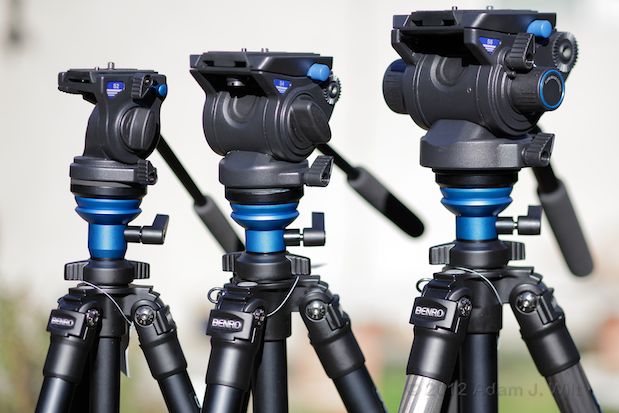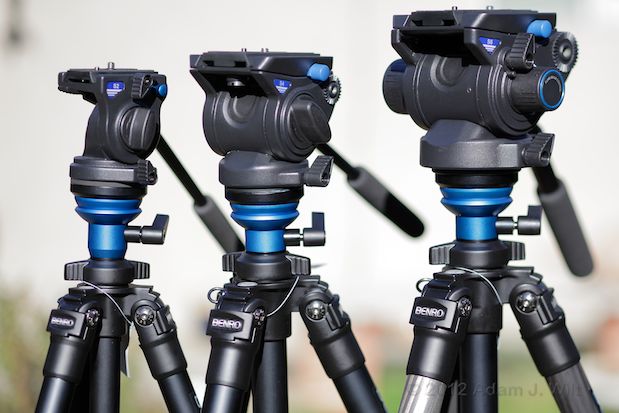
Chinese photo-equipment company Benro has been making tripods and heads under its own name for the past decade. At NAB 2012 they introduced a new line of kits with fluid heads for video use, and these started shipping in October. Benro’s US distributor sent me three representative kits, with both aluminum and carbon fiber sticks and three different fluid heads, to test and compare.
The kits are largely differentiated by their heads: the S2 head is rated for a 2.5 kg camera (5.5 lbs), the S4 should support a 4 kg / 8.8 lb camera, and the S6 can carry a 6 kg / 13.2 lb load. Benro offers kits for these heads with aluminum and carbon fiber (CF) legs. One vendor, Adorama, prices these kits as follows:
Kits with aluminum legs:
A1573FS2, $200
A2573FS4, $275
A2573FS6, $300
Kits with carbon fiber legs:
C1573FS2, $318
C2573FS4, $440
C2573FS6, $465
All kits use three-section tripods with center columns; the S2 kits use a slightly smaller set of sticks than the S4 and S6 kits, but the design is the largely the same regardless of size.
Benro supplied me with the aluminum S2 and S4 kits, and the carbon fiber S6 kit.
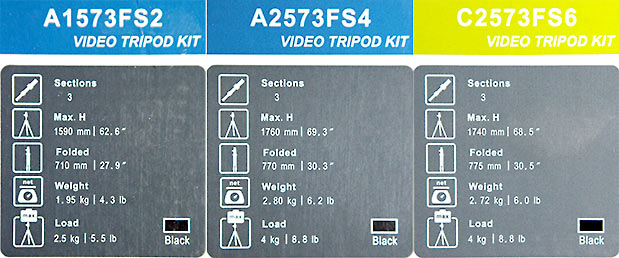
Basic specs on the three kits, succinctly summarized on their box labels. The S6 load spec appears to be a typo.
Design
All the kits consist of three-section tripods with flip-lever leg locks, a non-removable center column with a leveling bowl, and a flat platform with a 3/8″ screw for attaching a head. The three heads have fluid pan and tilt, quick-release (QR) plates, and a single handle or pan bar.

Benro S2, S4, and S6 Video Tripod Kits.
Tripods
Tripod legs are of black-finished aluminum or carbon fiber. One leg has a closed-cell foam rubber grip on it.
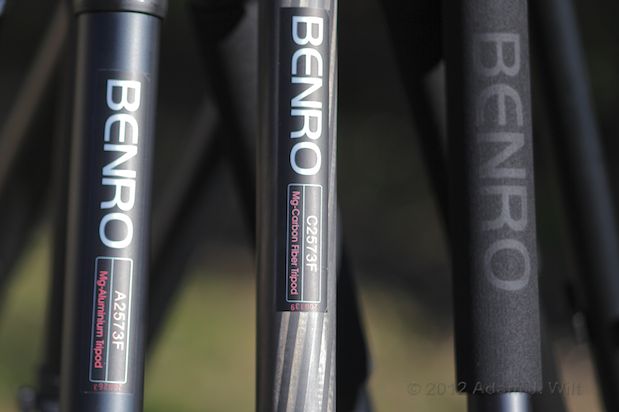
Tripods use aluminum or carbon-fiber legs and have closed-cell foam grips.
Leg sections are clamped in place using flip-lock paddles. The middle section has an anti-rotation fitting in it so that it doesn’t spin when unlocked; its paddle will always remain on the outside, parallel to the top-section’s paddle, making it easy and predictable to operate by touch alone.
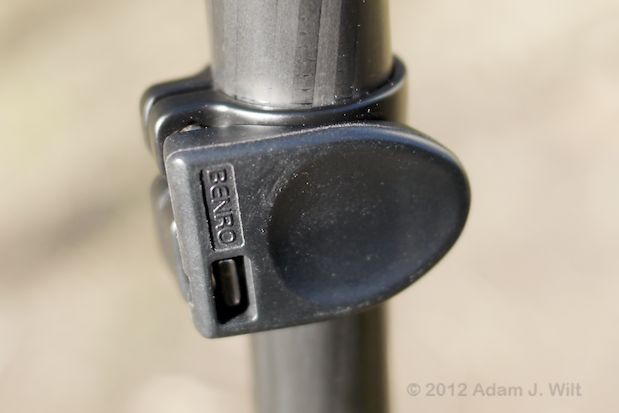
All three tripods use these flip-out leg-locking paddles.
Lock tension is adjustable using the supplied, clip-on combination cable clamp and paddle wrench.
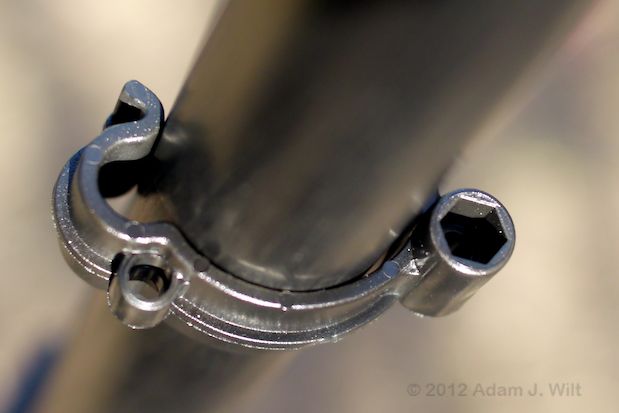
Each tripod has a snap-on combo lock-paddle wrench and cable clip.
The legs come together at a black-painted top casting, and held firmly in place with adjustable bolts. The legs have pop-out stops that land on any of three limits in the top casting, letting each leg lock at (roughly) 30, 60, or 80 degree settings.
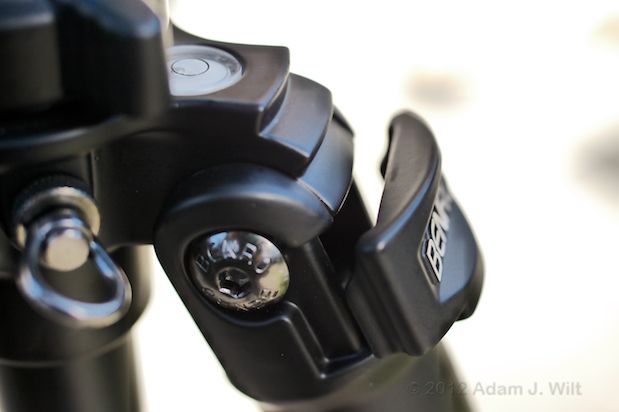
Pop-out stops allow legs to hit three different limits.
These let the tripod go very low—low enough that the center column becomes the limiting factor in how close to the ground you can get (about 16″ to 18″, depending on the head).
Legs terminate in rubber feet, which can be removed and replaced with metal spikes. A set with three spikes, plus hex keys to adjust the leg bolts and tighten the hex bolts on the head, is supplied with the kit.
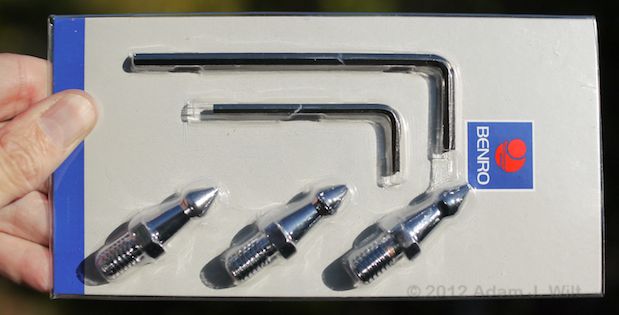
Each kit comes with two hex keys and a set of spiked feet.
The top casting incorporates a bubble level, a magnetic compass (!), and a small, freely-spinning metal loop, the purpose of which is undocumented.
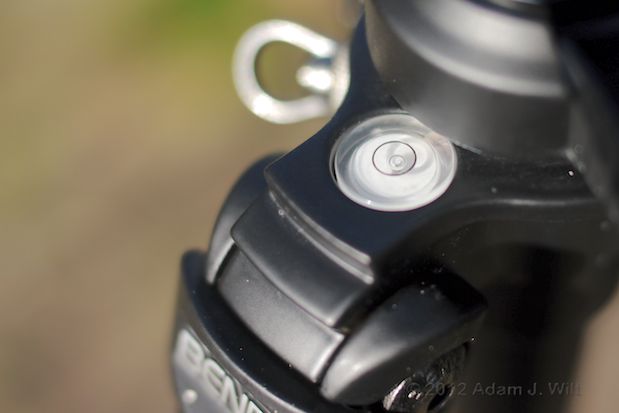
All the tripods have bubble levels.
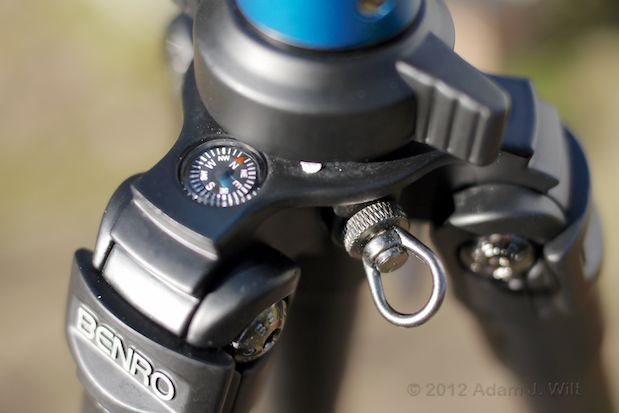
The tripods include magnetic compasses, and a rotating metal loop of unknown purpose.
A center column slides freely through the top casting and is locked in place with locking collar. It has a spring-loaded, pull-out hook at the bottom from which you can hang a stabilizing weight, should you feel the need.
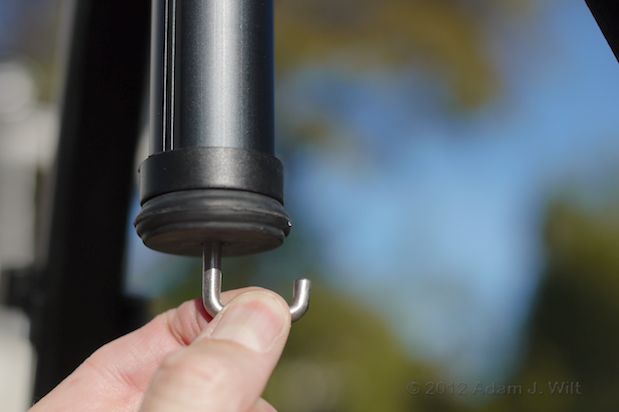
The center columns have spring-loaded weight hooks.
The columns are topped off with an elegant blue-anodized leveling bowl. The bowl locks in place with a twist lever; the twist lever’s head can be pulled out and rotated to position it for best advantage, like locking levers on high-end support gear. Twisting the lever less than half a turn frees the bowl to rotate freely, up to about 15 degrees in any direction, making it quick and easy to level the head even if the tripod itself is standing slightly askew.
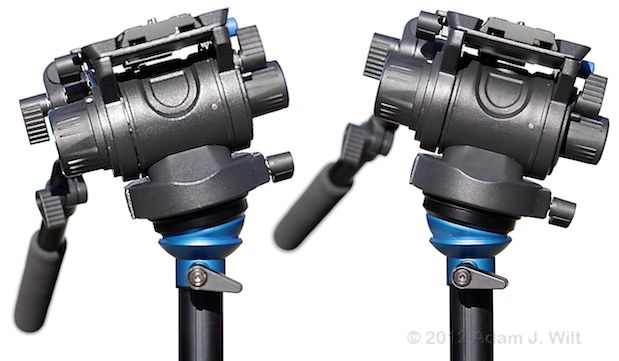
The leveling bowl allows fifteen degrees of freedom in any direction.
The leveling bowl has a standard, 60mm-diameter platform with a 3/8″ mounting screw. The heads screw down on those platforms, but can be removed if needed.
Fluid Heads
The three heads scale up from the featherweight, single-sided S2 to the feature-rich S6. All heads offer a fixed amount of fluid pan drag, fixed or variable fluid tilt drag, and a slide-in quick-release plate similar to those on lightweight Manfrotto or Vinten heads. All have their own bubble levels. Their handles are clamped to rosettes, allowing rotation to many angles or complete removal when necessary.
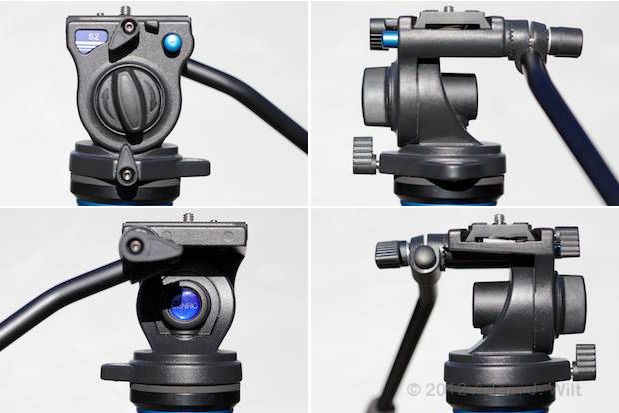
The S2 head, a very light, single-sided design.
The S2 is a tiny head using a smaller quick-release plate than the S4 and S6. The QR plate has a 1/4″ camera screw and a retractable anti-rotation pin.
It’s a single-sided head, with most of its adjustments on the left side. At the base, there’s a locking lever for panning; a large rotating knob in the middle for tilt locking, and a lock lever at the top for the QR plate. Behind the lock lever there’s a blue-anodized release button for the QR plate’s safety catch.
The right side has a rosette for the pan handle. On the S2, the handle can only be attached to the right side.
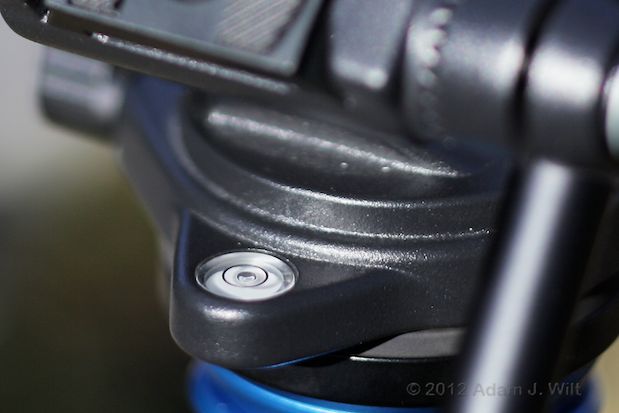
S2 and S4 heads have unlit bubble levels.
The S2 and S4 share the same bubble level in a bulge at the base of the head.
The S2 head tilts 85 degrees in either direction. It is not countersprung or counterbalanced in any way.
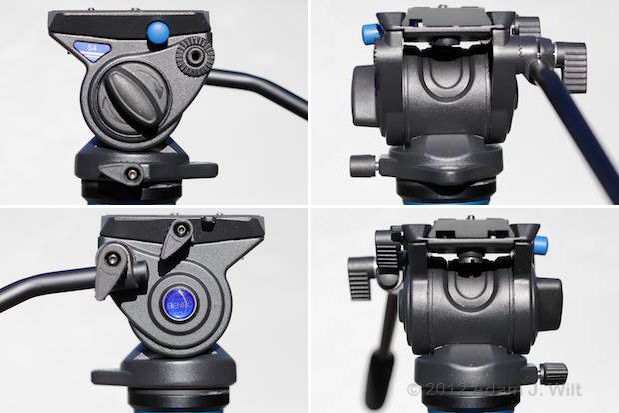
The S4 head, double-sided for more rigidity.
The S4 is an intermediate head with a bit more solidity. Like the S2, it has a pan-locking lever at the base and a large knob for tilt locking, both on the left, but its QR lock lever is on the right. Rosettes on either side let you mount the pan handle on the left or right as suits your mood.
The QR safety release is a large blue plastic button, instead of the smaller blue-anodized metal one on the S2. As you can see in the photo, it’s rather loosely retained, and can flop around a bit.
The S4 is supplied with both 1/4″ and 3/8″ camera screws. When not in use, the 1/4″ screw threads into the underside of the top platform at the rear, while the 3/8″ screw lives under the front of the platform.
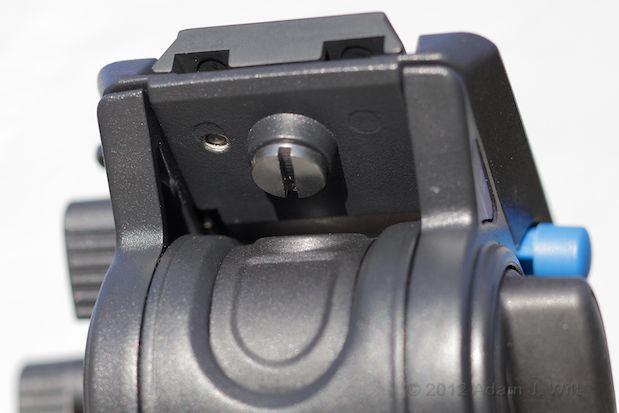
The S4 stores its 3/8″ screw at the front, 1/4″ at the rear.
The S4 tilts about 75 degrees back and perhaps 85 degrees forward—but not with the 3/8″ screw in its storage place. That screw limits the forward tilt of the head slightly by whacking into the base. If done repeatedly or with vigor, it will likely mar the finish; I tried not to test this. If you’re downshooting documents you can use the flexibility of the tripod’s leveling bowl to add the additional tilt needed for a full 90 degree forward tilt.
The S4 appears to have a light counterbalance spring in it, as tilting the unloaded head all the way forward and releasing it causes it to spring back slowly.
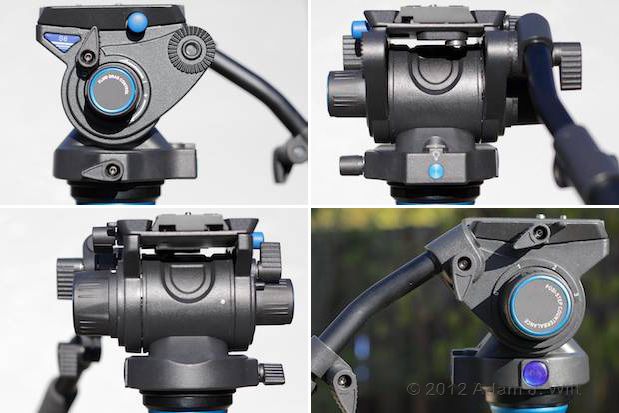
The S6 head, with both a four-level counterbalance and a tilt drag adjustment.
The S6 is the heavyweight of the trio: it’s the only one with adjustable tilt drag and adjustable counterbalancing. It still has left-mounted locking levers for both pan and tilt, but it also has a large, blue-rimmed adjusting knob for tilt drag. Like the S4, the S6 has a large and wobbly plastic safely release for the QR plate.
On the right, another blue-rimmed knob lets you set one of four counterbalance positions, one of which is no counterbalance at all.
The S6 shares the same QR plate as the S4, and the same two camera screw choices, but the S6 stores both of them at the back of the platform.
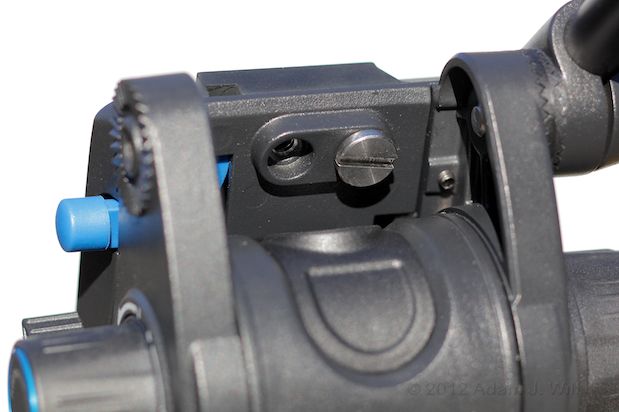
The S6 head stores 1/4″ and 3/8″ screws under the rear of the platform.
The S6 tilts back about 60 degrees and forwards around 80 or 85 degrees. Tilt drag can be continuously varied from none at all (or close enough as makes no practical difference) to a pleasingly high degree of resistance.
The S6 also has an illuminated bubble level, a very handy feature:
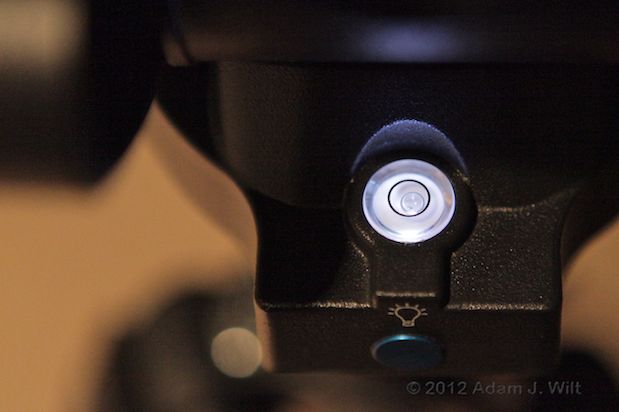
The S6 head has an illuminated bubble level.
The S6 ships with a button battery installed and a spare as well.
All the heads use QR plates with a slot for the camera-fixing screw. The slot lets you slide the camera back and forth for better balance. A rubber plug at the back pops out should you need to change the camera-fixing screw. The plates include an anti-rotation pin at the front for video cameras that accept them. If you’re using a camera without the appropriate socket, or if you want to slide the camera back on the plate for balance, the pin can be pushed down against a leaf spring to retract it.
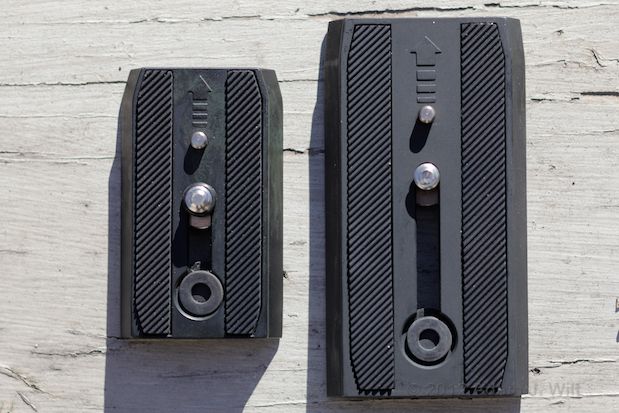
S2 and S4/6 quick release plates, top view.
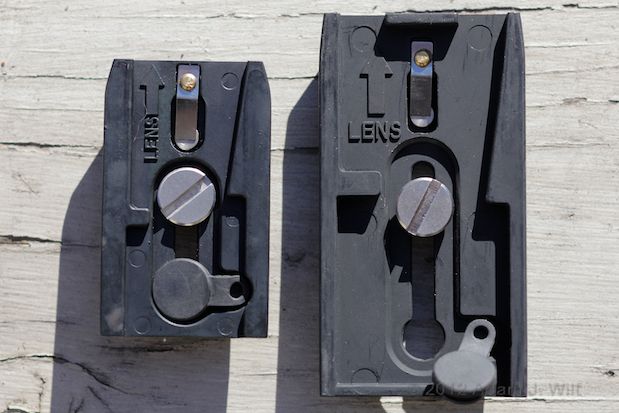
S2 and S4/6 quick release plates, bottom view.
The S2 and S4 heads have thin, one-piece handles. The S6 uses a more substantial two-piece extendable handle. All handles have comfy foam-rubber grips.
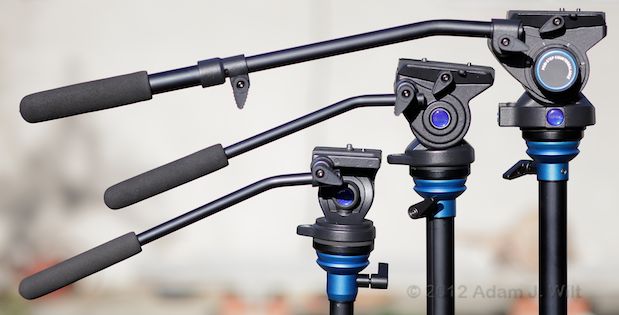
S2 and S4 use one-section handles. The S6 handle has two sections.
Bags
The kits come packed in zippered carrying bags. The bags have carrying handles and come with detachable shoulder straps. The bags have internal zippered pockets containing the spiked feet and wrench kit as well as a packet containing one-sheet Chinese/English instructions for the head and for the sticks, the warranty card, and (for the S6) a spare illumination battery and a hex key for the battery compartment.
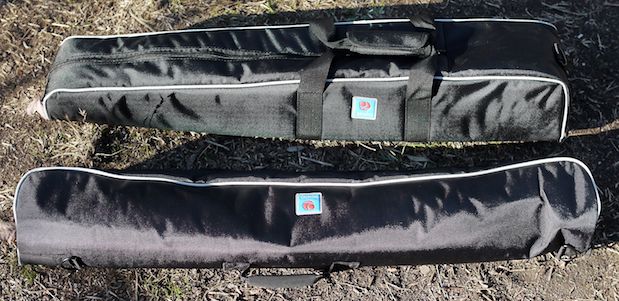
Travel bags for the S6 and S4 kits. The S2’s is like the S4’s, only smaller.
Next: Operation and Handling; Impressions; Conclusion…
Operation and Handling
I’m picky with support systems: I want something that lets me move smoothly and predictably, and gives me no stiction (static friction, which causes jerky starts and stops) or springback (where, once you stop applying pressure to the pan handle at the end of a move, the tripod and head “unwind” stored tension, pushing the camera back slightly in the direction it came from). The support system also needs to be absolutely stable, so that the camera doesn’t wobble or vibrate at the slightest provocation, and so that any induced vibrations damp out immediately instead of oscillating the camera as if it were mounted on a bouncy spring.
I spent eight years looking for a kit I could be satisfied with for my Handycam work, finally settling on a $2000 Vinten Vision 3 with dual-stage carbon fiber sticks (this was some years ago; the current closest equivalents would be the Vision blue5 and Vision 3AS kits with dual-stage CF sticks). It was the smallest, lightest, and cheapest system I could find that gave me the smoothness, solidity, repeatability, and control I required, and it has held up everything from sub-two-pound palmcorders up through shoulder-mount 2/3″ camcorders like the (now ancient) DSR-500.
Of course, not everyone is willing or able to spend $2000 on a set of sticks, yet they still want something with a smoother action than a still-photo friction head and a more stable support than the flimsy, sub-$100 budget tripods cluttering the floor in the photo section at Walmart or Best Buy. That’s the market these Benros target.
Lightweight systems like the S-series Benro kits are, by their very nature, compromises. You will not find rock-solid rigidity and stiction-free fluid heads at these prices: the sticks are simply too lightweight to have the stiffness and solidity of larger supports, and the heads lack the silky precision of pricier counterparts. Rather, the trick at this level is to find sticks that are stable enough and a head that is smooth enough to get you close enough to perfection, at a price, weight, and bulk that you’re happy to carry.
Tripods
Benro’s tripods fare well in these tradeoffs: they are very stiff for their weight, or put another way, they’re very light for their stiffness. With their legs collapsed, they are, to all intents and purposes, as solid as a rock. As you extend the legs, they become slightly more flexible; at full extension, they show visible flexing as you pan and tilt, but the flexing is no worse than with other tripods of similar weight and construction, and it seems to me that the Benros perform somewhat better in this regard than the average for similar tripods. I spent some time at our excellent local photo-gear store, Keeble & Shuchat, and found well-regarded single-tube-leg tripods costing twice what the Benros do that had the same or greater rubberiness under load.
The smaller A1573 sticks were wobblier than the beefier A2573 sticks, as might be expected. But the difference between the A2573 and C2573 sticks—aluminum versus carbon fiber—wasn’t as great as I expected. Yes, the CF sticks are a little bit lighter and a little bit more rigid, but at this scale, leg length and tube diameter appear to be more significant than leg material.
The hinges securing the legs to the top casting showed no signs of slop or flexing. They held their legs solidly in place and required a consistent and appropriate amount of force to fold the legs in or to pull them out. The pop-out limit stops on the legs worked well, as long as I remembered to push them back in enough to engage the desired step on the top casting!
The flip-locks for leg extension worked very well. The paddles are nicely contoured and take just the right amount of force, and they locked their leg segments securely in place. I found that extending and collapsing the legs was as fast and easy to do with the Benro as with any other set of sticks I’ve used, and I was quite happy to set the legs entirely by feel, without looking at what I was doing. The paddles have an “over-center” action so that they snap firmly shut when locked; they don’t leave you guessing as to whether or not you’ve pushed them down far enough.
On a couple of the legs, the locks were loose enough that if I leaned heavily on the tripod I could cause it to subside, but a quarter-turn of the clamp’s adjusting nut with the supplied wrench made the lock entirely resistant to my overbearing pressure without materially affecting the force required to flip the paddles.
The center column slides freely up and down once its locking collar is loosened. Although it’s keyed, it can and will rotate slightly side-to-side, causing unwanted bumps when panning, unless the locking collar is tightened down very severely.
The leveling bowl is a pleasure to use; it’s buttery-smooth in its action and it locks down securely, making head leveling fast and easy. The locking lever’s handle can be pulled out and repositioned, which turns out to be necessary as the lever can interfere with the center column’s locking collar when the column is lowered all the way.
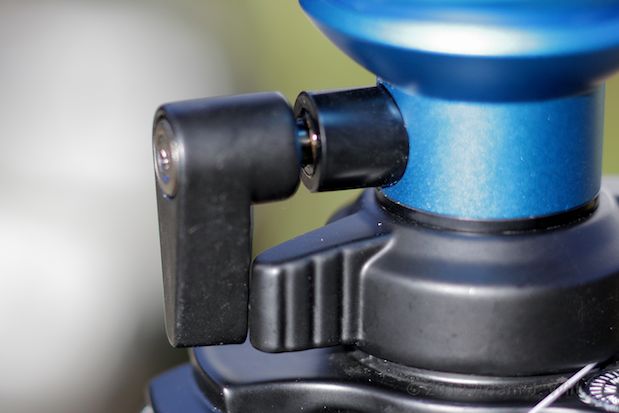
The leveling lock can sometimes interfere with the column collar.
Heads
All the heads have pan and tilt locks: mechanical friction brakes to keep the head from rotating. For panning, that’s the only control you get to adjust pan drag, and it’s an imprecise control at best; in the short throw between unlocked and locked, the locking levers increase drag, but in the same sticky manner as the locks on a friction head.
Even with the lock fully off, pan drag on all three heads is quite high: with no camera on the head, attempting to pan any of the heads at a moderate speed caused the tripods to jump and skitter around on a polished floor. Even with a 4-pound camera like the DV-format AG-DVX100 on board, executing a 90-degree-in-four-second pan required a steadying hand on the tripod itself to keep it firmly planted.
The S2 and S4 have large knobs for the tilt lock; the S6 has a lever for the tilt lock and a large knob to adjust fluid drag. The S6’s separation of the “lock” and “drag” functions is a welcome feature; the drag adjustment allows a high degree of control, from virtually no drag at all to a very high, resistant feel. However, the slippery and stiff drag knob requires a tight grip to turn it, and the locking lever gets in the way of easy adjustment, limiting how far you can rotate the knob with a single grasp.
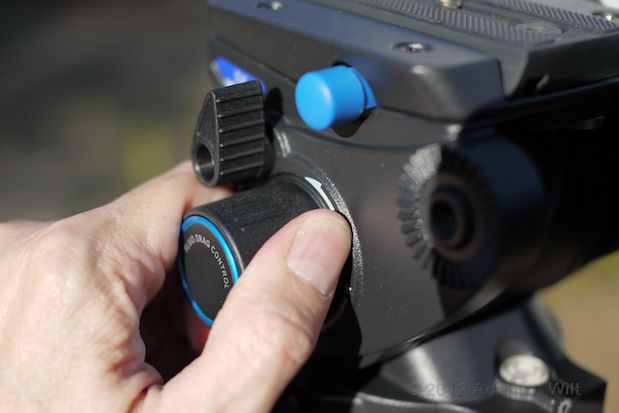
Adjusting the drag knob on the S6.
I wound up tilting the head as I twisted the knob to let me keep a grip on it longer.
The S2 head has a fixed tilt drag with considerable resistance. Both tilt and pan drags seemed high for such a small head; performing a normal, follow-the-actor-across-the-room move required a fair amount of push, and I could feel the thin pan handle flexing under the load (having said that, my personal preference is for fluid drags to err on the side of being too high rather than too low, for increased smoothness).
Pan and tilt drags seemed reasonably well balanced; the head didn’t show any tendency to pan when I wanted a tilt or vice versa. Diagonal moves didn’t cause any bobbles or surprises.
The light, single-sided head flexed more under load than the others, though not normally enough to be noticeable in the picture. Instead, it appeared as springback: both pan and tilt recoiled visibly when I relaxed pressure on the handle after a move.
Springback happens when a twisting load imparted to the support system during a move is released. The drag of a pan or tilt puts a twist into the tripod and head, which, at the end of the move, has to be released somehow. In the ideal case, the tension slowly releases through the head’s fluid damping. If you hold the pan handle for a second or two at the end of the move, the stored energy dissipates, and you can then let go of the handle without having the camera move. In such cases, springback is transient, and is avoided simply by holding your position for a short while.
In elastic loading, tension remains in the tripod and head at the end of the move, but stiction prevents it from releasing; no matter how long you hold the camera in place after the move, when you let go, the camera will spring back a bit.
The S2 head suffered from elastic loading: even if I held my shot for ten seconds after a move, the camera would always spring back substantially if I then relaxed my grip. Both pan ands tilt were affected in equal amounts. At full wide angle springback was noticeable, while at telephoto it was hugely annoying. Operating with the S2 required a constant grip on the handle to keep the camera aimed: fine perhaps for a short take in a scripted film, but not so good for long-duration event recording.
The S2 also has a slight amount of stiction in both axes, not enough to really impede operation (especially given the high viscous drag), but enough that I wound up putting my GH2 with 12-35mm lens on it to shoot some of the stills in the review without worrying about it dumping if I turned my back on it.
The anti-rotation pin in the S2’s QR plate was so tightly fitted that I couldn’t push it down without using a coin as a load-bearing surface, and once pushed down, it wouldn’t pop up again unless I attacked it from underneath.
The S4 head is bigger and mechanically stiffer than its little sister, and its pan handle felt less willowy. It didn’t suffer as much springback as the S2 did, and its tilt drag seemed to be a bit lower.
However, the S4’s tilt mechanism suffered from more stiction, so starting and stopping tilts precisely took a bit more heavy-handed care than making a smooth pan. Diagonal moves similarly tended to start off with pure pans followed by a dogleg back to the diagonal as the tilt stiction let go—I’m being perhaps more dramatic in my description than the effect on-screen might deserve, but I’m trying to convey the feeling of performing a delicate move.
Dialing in a bit of tilt drag with the side knob stiffened things up a bit, reducing the relative effect of the stiction, but it did so by increasing the sliding friction overall (which tends to be invariant with speed) rather than increasing the viscous drag (which varies with speed). I found that a very slight stiffening better harmonized the balance of pan and tilt frag, but the stiction remained the same. Eases into and out of diagonals still favored the horizontal move over the vertical.
One evening, I got distracted when changing batteries on the DVX100, and left the camera on the head overnight with the tilt lock off. The next morning, it hadn’t moved—but when I tapped it, it fell forward to the vertical, despite the weak counterbalance spring. That’s more stiction than I like.
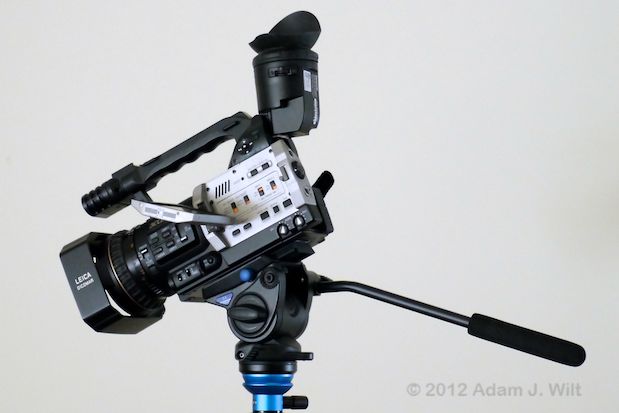
The S4, unlocked, held the DVX100 in this position overnight.
The S6 head was the best of the bunch. While its pan drag remained fixed, the tilt drag was completely and smoothly variable. I could take it entirely off to allow lightning-quick tilts, dial it way up for molasses moves, or adjust it in between to perfectly harmonize with the pan drag. Neither pan nor tilt suffered from excessive elastic springback, nor were they plagued with noticeable stiction; I could move the camera smoothly from point to point, and after a second let the pan handle go without the camera moving back of its own accord.
The S6 also has a four-position counterbalance setting. In position 0, the head was free-falling; in 3 it was securely held up, even with a six-pound camera (Canon 5D Mk II with 70-200 f/2.8 zoom, perched on the zoom’s mounting collar) attached. I found that with any of the cameras I tried, from two to six pounds load, I usually had the counterbalance on settings 1 or 2.
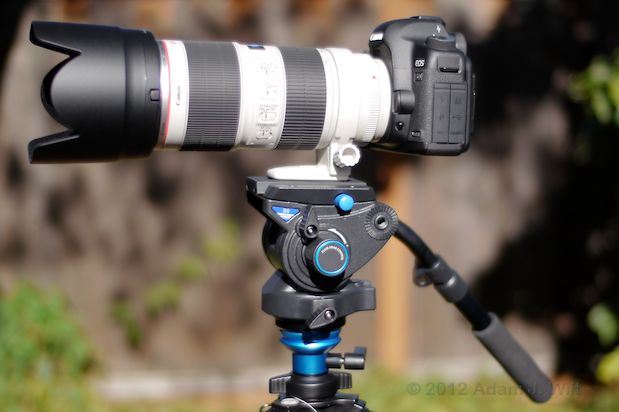
The S6 supporting a Canon 5D Mk II with 70-200mm f/2.8 zoom.
The S6’s telescoping handle was very solid, even at full extension. That longer lever arm helped me make delicate moves with relative ease, as did the higher stiffness of the larger-diameter handle tube.
In only one aspect did the S6 and S4 lag behind the S2: their sloppy plastic safety catches for the QR plate tended to pop up into the dovetail channel when the plate was removed, blocking the re-insertion of the plate unless the button was held in at the same time. The S2’s more precise metal mechanism let its QR plate slide in more easily without a lot of fiddling around.
Overall
The high pan drag of all three heads meant that unless I screwed down the locking collar on the center column very tightly indeed, a pan would first spin the column before the head would rotate by itself.
The weight hook at the base of the center column has a tight, right-angle hook on its end. Combined with the strength of the spring and its short extension, it made maneuvering the strap of a five-pound sandbag on and off the hook a bit more troublesome that I would have liked, and the creaking the hook gave off when the sandbag was hung from it gave me pause.
The leveling bowl at the top of the column worked like a charm; it gave me pleasure every time I set up for a new shot (I have two ancient center-column tripods I use for stills, a Quickset and a Viola, and as you might guess, neither one has such an amenity).
All three tripods set up and tore down with no jams, collapses, or surprises of any kind.
The heads were a mixed bag. I was actually surprised at how well the S2 worked—as long as I kept a death grip on the handle to prevent springback. I could see doing short takes using a light camera on the S2, but I wouldn’t want to use it for long-form event work, nor for anything where absolute precision was required.
The S4 similarly worked well enough if I concentrated on what I was doing, to overcome the tilt stiction and ensure a smooth move, but it was still a head that required my active attention to overcome its limitations.
The S6 was the clear winner: its lower stiction and springback, combined with its adjustable counterbalance and tilt drag, made it a more predictable, more tweakable, more compliant support. Of the three, it was the easiest to operate and gave me the smoothest, most repeatable moves. It was the only one of the three that I’d consider for any sort of long-form work; between the lack of springback and the adjustable counterbalance, it allowed me to move to a new position and take my hands off the controls, with reasonable assurance that the camera would stay where I left it. While it’s not at the level of a Vinten Vision 3 at five times the price or an O’Connor 2060 at twenty-five times the price (grin), it’s not bad for what it costs.
Impressions
The Benro kits look classier and operate better than they should at the price, at least at first glance. When you start looking closer, you start seeing things that help explain that price/performance tradeoff: rough edges, inconsistent quality control, and a lack of attention to certain fit-and-finish aspects.
The S4 head creaked and wobbled alarmingly at first, until I used the (included) hex wrench to properly tighten the bolts holding the top platform to the right side.
The weight hook is a simple steel rod bent ’round and cut off sharply, leaving sharp edges at its tip, where a more careful manufacturer might radius the corners a bit more and round the tip off smoothly.
The S2’s QR plate had an odd, verdigris-like discoloration on its dovetail wedges (visible in the image above), and its anti-rotation pin jammed tightly in its hole.
Many of the various levers had untrimmed flashing along their mold lines, and leftover pigtails of plastic wrapped around their metal shafts.
The plastic safety catches for the QR plates on the S4 and S6 flopped about in their grooves and often jammed the QR plates if they weren’t first pushed out of the way.
I decided to try changing the battery on the S6’s bubble level. The supplied wrench was too small for the cover’s bolts, but I had my own 2mm wrench that fit perfectly. Upon removing the cover, quite a few lumps of hot-melt glue-gun glue fell out (at least, I hope it was hot-melt glue!), and a large dollop of the stuff with embedded electronic scrap remained stuck inside the chamber.
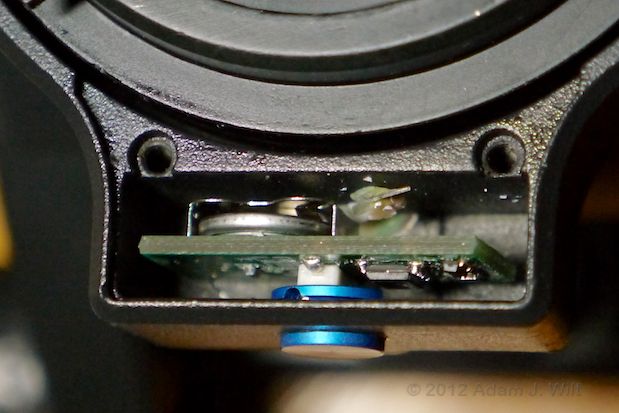
Inside the S6’s light chamber, after dumping out debris.
The S6’s carrying bag was well designed, with carrying handles offset towards the heavier head end of the bag and a double-pull zipper running between them. The S2 and S4 bags have centered handles; when you carry them, the heavy head pulls its end of the bag down.
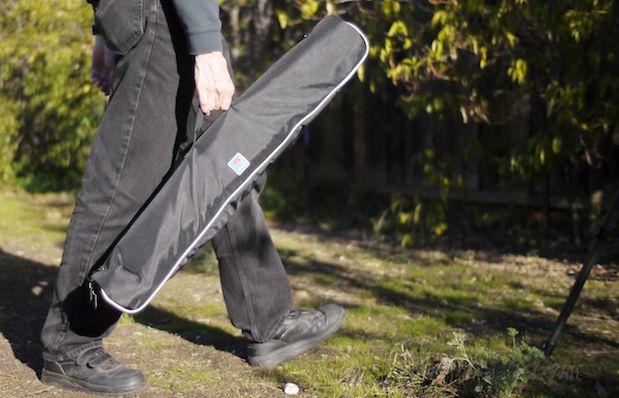
S2 and S4 bags’ centered handles mean the bags sag towards the heavy end.
The zippers on these bags are on the bottom of the bag (the side opposite the carrying handles), so that when you put the bag down its zipper is pushed into the dirt, and you have to flip the bag over to extract the tripod. Did the Benro folks simply tell a new guy to go make some bags, and not look at the results before putting them into production?
All the heads make faint sucking and squishing sounds when panned or tilted quickly, and they have odd daubs of grease here and there that I would have expected to have been wiped off prior to shipment.
In a way, I’m reminded of movie props or inflatable dummy tanks—things that look good from a distance but are less convincing close up. I’m left wondering whether the progression in pan quality I experienced as I moved up from the S2 through the S4 to the S6 is actually due to differences in the design of the lookalike pan sections, or if it’s due instead to accidental variations in build quality that just happened to correlate with the price of the heads. Maybe I just got lucky?
I also wonder, given the green mottling on the S2’s plate, what the quality of the surface finishes is, and how well these kits will hold up cosmetically under extended use.
I may simply be seeing “teething troubles” with first-generation kit. Benro has been making tripods for over a decade, and (aside from the inelegant weight hook) the tripods themselves appear to be well-thought-out, fully-functional items. The heads are where I see the most inconsistency and rough edges; as the production line gets more experience both quality control and fit-and-finish may improve. If the tripods are any guide, next-generation Benro heads will likely improve both in design and in smoothness.
In any event Benro USA warrants these kits for five years, which indicates a certain degree of confidence in their long-term reliability.
Conclusion
Benro’s S-series video tripod kits are attractively priced from $200 to $465.
The tripods are as light and as stable as anything else their size, and they operate smoothly and consistently. The smaller 1573 sticks are a bit on the small and wobbly side for my taste, but the larger 2573 series sticks offer plenty of height and are rigid enough to be genuinely useful.
The heads are an odd lot. The tiny S2 is a bit too bendy and suffers from considerable springback. The S4 is better, but its tilt stiction is bothersome. Neither the S2 nor the S4 gives you any real control over tilt drag or balance. The S6 offers fully-adjustable tilt drag and a four-position counterbalance, and it has the smoothest, least sticky action of the bunch.
All of them have a fixed amount of pan drag, which is disappointing but par for the course at this price point.
The S2 kits combine a slightly-too-small-to-be-solid tripod with a not-ready-for-prime-time head. The S4 kits have decent sticks, but the head—while better than a friction head—isn’t as smooth and as usable as I’d like. The S6 head is at least twice as good as the S4 when it comes to doing the things you buy a fluid head for: making smooth, consistent, and repeatable moves. Kits with the S6 command a mere $25 premium over kits with the S4 and I’d say it’s money well spent.
Aluminum or carbon fiber? The A2573FS6 costs $300 while the C2573FS6 will set you back $465: that’s a $165 “carbon tax”. The CF weights 0.9 pounds less (the CF kit weight is 6.0 lbs / 2.7 kg, versus 6.9 lbs / 3.2 kg for aluminum), it’s a wee bit stiffer, and it undoubtedly looks cooler. Whether those advantages outweigh the price difference is something only you can determine; if I were buying one myself, I’d opt for the aluminum kit as having the best price/performance tradeoff.
I have to admit that when I first saw these kits I wasn’t expecting much, and the fit-and-finish issues did nothing to boost my enthusiasm. But as I worked with them a bit, my opinion changed; the tripods set up and tore down smoothly and easily and were as rigid as anything else I’d used in their price and weight classes. While I didn’t warm to the S2 or S4 heads, the S6 head impressed me as something I could actually use without being frustrated by its limitations (and recall that I’m the guy who spent eight years looking for a tripod and head combo I could live with).
In summary, if you’re in the market for a sub-$500 tripod kit, Benro’s S6 offerings should be on your short list for evaluation, in aluminum or carbon fiber as you see fit.
Pros
- Tripods are stiff and lightweight for the price.
- Choice of aluminum or carbon fiber legs.
- Three-section legs and center column offer ample elevation.
- Fast-operating, secure, and touch-friendly leg locks.
- Leveling bowls make setup very quick and easy.
- Three-position limits stops let legs splay outwards as needed.
- Both 1/4″ and 3/8″ camera screws supplied (S4 and S6).
- S6 head has very good tilt drag and counterbalance settings for the price.
- S6 head is very smooth and repeatable.
- S6 head has sufficiently rigid, dual-section pan handle.
- S6 head has illuminated bubble level.
Cons
- S2 and S4 heads lack tilt drag and counterbalance adjustments.
- All heads lack proper pan drag adjustments.
- S2 head has excessive springback in both pan and tilt.
- S4 head has too much tilt stiction.
- S4 and S6 heads have cheap-feeling, wobbly QR plate safety catches.
- S2 and S4 kit carrying bags are poorly designed.
Cautions
- Benro S-series heads are first-generation products, so long-term reliability can’t be predicted.
- All tripods get wobblier the more their legs are extended.
- Center column can’t be removed, and it limits how low the head can go.
- The kits I tested have fit-and-finish and quality-control issues. These may diminish as manufacturing cranks out more kits, but they are things to be aware of nonetheless.
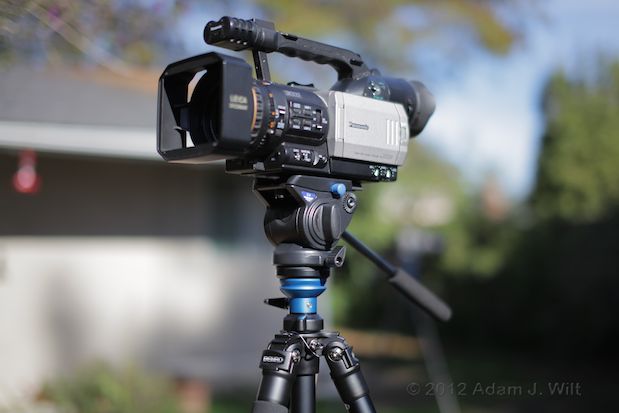
S4 kit supporting an AG-DVX100.
Disclosure: Benro sent me three tripod kits for review and paid shipping both ways.
This is a “sponsored review” in that Benro’s US distributor paid me (through PVC) to look at their products; normally, I pick what I review, and am compensated only based on the number of page views the review gets. Payment was not contingent on the review being favorable; I wrote what I think of the products, plain and simple.
Aside from that, no material connection exists between me and Benro. No one has offered any payments, freebies, or other blandishments in return for a mention or a favorable review.
I used Adorama’s prices in the review because they were easy to find. I have no relationship to Adorama other than as a customer; Adorama wasn’t consulted for the review nor have they offered me anything for the shout-out. The same goes for Keeble and Shuchat: I’m a happy customer of theirs, but that’s as far as it goes.

Filmtools
Filmmakers go-to destination for pre-production, production & post production equipment!
Shop Now